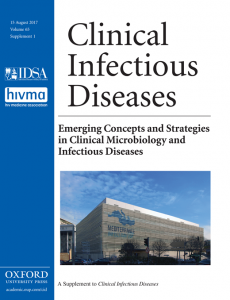 Post-publication peer review isn’t just for scientists. Newspaper reporters can help correct the scientific record, too.
Post-publication peer review isn’t just for scientists. Newspaper reporters can help correct the scientific record, too.
The U.S. Centers for Disease Control and Prevention (CDC) has corrected a journal article on Legionnaire’s disease after the Pittsburgh Post-Gazette revealed what seems to be efforts by the researchers to misrepresent their data.
In a series of articles last December, the newspaper raised questions about the CDC’s actions in the aftermath of outbreaks in 2011 and 2012 of Legionnaire’s that sickened 22 veterans, killing six. The Post-Gazette obtained emails from CDC scientists that appeared to reveal their disdain for the sterilization method the hospital had been using to suppress the growth of Legionella bacteria. That method, a copper-silver system, is widely considered to be effective. But according to the newspaper, the CDC investigators were so critical of the copper-silver disinfectant technology that the VA ultimately switched to a system based on chlorine.
According to the Post-Gazette, the CDC researchers were determined to blame the outbreaks on the copper-silver system while minimizing the role of human error in the illnesses. That view proved at odds with the conclusions of a 2013 report from the VA’s Inspector General, which found that “the outbreak was due to poor management generally and poor maintenance of the copper-silver system specifically — not that the copper-silver system itself had failed,” the paper reported.
Preconceptions are bad enough in science, and that dispute could arguably boil down to “tomato-tomahto.” After all, it’s certainly possible that many factors played important roles in the outbreaks. What follows, however, is far more damaging to the image of the agency as an outpost of objective science.
As the Post-Gazette uncovered, the CDC’s report on the Legionnaire’s cases, which appeared in Clinical Infectious Diseases in 2015, misstated the study data in a way that either was head-scatchingly obtuse or deliberately misleading.
According to the newspaper:
In an email the Post-Gazette obtained, the researcher, Claressa Lucas, who conducted the test, wrote to her colleagues and told them that “at” 24 hours the optimal level of 400 parts per billion of copper and 40 ppb of silver showed a “significant decrease in viability” of the Legionella, but not at the prior time point of three hours.
But in the journal article, the CDC reported that its test found that the 400/40 ppb “copper-silver solution, although above the manufacturer’s recommended target concentration for Legionella eradication, failed to reduce viability of any strain within 24 hours.
Per the correction:
An error occurred in a 1 June 2015 article [Demirjian A, Lucas CE, Garrison LE, et al. The Importance of Clinical Surveillance in Detecting Legionnaires’ Disease Outbreaks: A Large Outbreak in a Hospital with a Legionella Disinfection System—Pennsylvania, 2011–2012. Clin Infect Dis 2015; 60:1596–602]. On the fourth page, under the Environmental Results section, the sentence stating “In addition, testing at the CDC’s Legionella laboratory revealed that a 0.4/0.04 ppm copper-silver solution, although above the manufacturer’s recommended target concentration for Legionella eradication, failed to reduce viability of any strain within 24 hours” is incorrect.
The corrected sentence should read as follows: “In addition, testing at the CDC’s Legionella laboratory revealed that a 0.2/0.02 ppm copper-silver solution at the manufacturer’s recommended target concentration for Legionella eradication failed to reduce viability of any strain within 24 hours (Figures 1 and 2), although higher concentrations of 0.4/0.04 ppm or 0.8/0.08 ppm copper-silver were able to significantly reduce Legionella viability at 24 hours.”
The online version of the article has been corrected, but the print version contains the original wording.
The authors regret this error.
The article, “The Importance of Clinical Surveillance in Detecting Legionnaires’ Disease Outbreaks: A Large Outbreak in a Hospital With a Legionella Disinfection System—Pennsylvania, 2011–2012,” has been cited 20 times, including once by the correction, according to Clarivate Analytics’ Web of Science.
We encourage you to read the Post-Gazette articles, which contain many more details and other intriguing sub-plots, including personal vendettas:
- CDC emails on VA Legionnaires’ investigation raise questions (December 11, 2016)
- CDC corrects journal article on Pittsburgh VA Legionnaires’ outbreak (July 23, 2017)
- Post-Gazette article spurs Rep. Murphy to ask new CDC head to take another look at Legionnaires’ investigation (July 25, 2017)
Of note, the Post-Gazette waited three and a half years for the emails, which
made it one of the single slowest responses from the CDC from more than 1,000 FOIA requests it received from all sources in 2013, according to the CDC’s own data on FOIA responses.
Like Retraction Watch? Consider making a tax-deductible contribution to support our growth. You can also follow us on Twitter, like us on Facebook, add us to your RSS reader, sign up on our homepage for an email every time there’s a new post, or subscribe to our daily digest. Click here to review our Comments Policy. For a sneak peek at what we’re working on, click here.
This latest revelation is consistent with my own and colleagues’ experience in dealings with the CDC. See: JH Noble JR 18 May 2015 comment re: Center for Disease Control and Prevention: protecting the private good? http://www.bmj.com/content/350/bmj.h2362/rapid-responses.